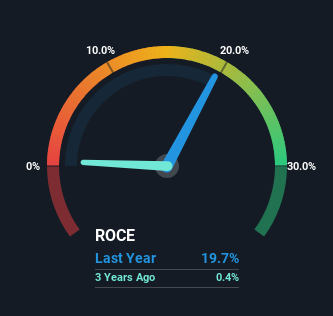- India
- /
- Trade Distributors
- /
- NSEI:SANGHVIMOV
We Like Sanghvi Movers' (NSE:SANGHVIMOV) Returns And Here's How They're Trending

What are the early trends we should look for to identify a stock that could multiply in value over the long term? Firstly, we'd want to identify a growing return on capital employed (ROCE) and then alongside that, an ever-increasing base of capital employed. This shows us that it's a compounding machine, able to continually reinvest its earnings back into the business and generate higher returns. So when we looked at the ROCE trend of Sanghvi Movers (NSE:SANGHVIMOV) we really liked what we saw.
What Is Return On Capital Employed (ROCE)?
For those that aren't sure what ROCE is, it measures the amount of pre-tax profits a company can generate from the capital employed in its business. To calculate this metric for Sanghvi Movers, this is the formula:
Return on Capital Employed = Earnings Before Interest and Tax (EBIT) ÷ (Total Assets - Current Liabilities)
0.20 = ₹2.4b ÷ (₹14b - ₹2.0b) (Based on the trailing twelve months to June 2024).
Thus, Sanghvi Movers has an ROCE of 20%. That's a fantastic return and not only that, it outpaces the average of 5.8% earned by companies in a similar industry.
View our latest analysis for Sanghvi Movers

Historical performance is a great place to start when researching a stock so above you can see the gauge for Sanghvi Movers' ROCE against it's prior returns. If you'd like to look at how Sanghvi Movers has performed in the past in other metrics, you can view this free graph of Sanghvi Movers' past earnings, revenue and cash flow.
What Can We Tell From Sanghvi Movers' ROCE Trend?
Shareholders will be relieved that Sanghvi Movers has broken into profitability. While the business was unprofitable in the past, it's now turned things around and is earning 20% on its capital. On top of that, what's interesting is that the amount of capital being employed has remained steady, so the business hasn't needed to put any additional money to work to generate these higher returns. That being said, while an increase in efficiency is no doubt appealing, it'd be helpful to know if the company does have any investment plans going forward. After all, a company can only become a long term multi-bagger if it continually reinvests in itself at high rates of return.
The Key Takeaway
To bring it all together, Sanghvi Movers has done well to increase the returns it's generating from its capital employed. Since the stock has returned a staggering 939% to shareholders over the last five years, it looks like investors are recognizing these changes. With that being said, we still think the promising fundamentals mean the company deserves some further due diligence.
On a separate note, we've found 1 warning sign for Sanghvi Movers you'll probably want to know about.
If you'd like to see other companies earning high returns, check out our free list of companies earning high returns with solid balance sheets here.
New: Manage All Your Stock Portfolios in One Place
We've created the ultimate portfolio companion for stock investors, and it's free.
• Connect an unlimited number of Portfolios and see your total in one currency
• Be alerted to new Warning Signs or Risks via email or mobile
• Track the Fair Value of your stocks
Have feedback on this article? Concerned about the content? Get in touch with us directly. Alternatively, email editorial-team (at) simplywallst.com.
This article by Simply Wall St is general in nature. We provide commentary based on historical data and analyst forecasts only using an unbiased methodology and our articles are not intended to be financial advice. It does not constitute a recommendation to buy or sell any stock, and does not take account of your objectives, or your financial situation. We aim to bring you long-term focused analysis driven by fundamental data. Note that our analysis may not factor in the latest price-sensitive company announcements or qualitative material. Simply Wall St has no position in any stocks mentioned.
About NSEI:SANGHVIMOV
Flawless balance sheet average dividend payer.
Similar Companies
Market Insights
Community Narratives




